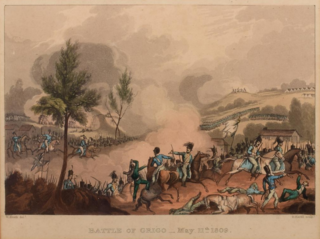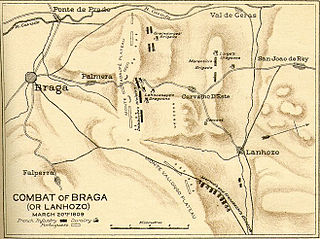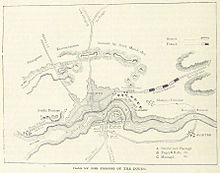
In the Battle of Vimeiro on 21 August 1808, the British under General Arthur Wellesley defeated the French under Major-General Jean-Andoche Junot near the village of Vimeiro, near Lisbon, Portugal, during the Peninsular War. This battle put an end to the first French invasion of Portugal.

The Battle of Talavera was fought just outside the town of Talavera de la Reina, Spain some 120 kilometres (75 mi) southwest of Madrid, during the Peninsular War. At Talavera, a British army under Sir Arthur Wellesley combined with a Spanish army under General Cuesta fought in operations against French-occupied Madrid. At nightfall, the French army withdrew a short distance after several of its attacks had been repulsed; the allies, having suffered comparable casualties to the French, made no attempt to pursue.

The Battle of Buçaco or Bussaco, fought on 27 September 1810 during the Peninsular War in the Portuguese mountain range of Serra do Buçaco, resulted in the defeat of French forces by Lord Wellington's Anglo-Portuguese Army.

The Battle of Grijó ended in victory for the Anglo-Portuguese Army commanded by Lieutenant-General Sir Arthur Wellesley over the French army commanded by Marshal Nicolas Soult during the Second French invasion of Portugal in the Peninsular War. The next day, Wellesley drove Soult from Porto in the Second Battle of Porto.

The Battle of the Pyrenees was a large-scale offensive that was launched on 25 July 1813 by Marshal Nicolas Jean de Dieu Soult from the Pyrénées region on orders of Emperor Napoleon in the hope of relieving French garrisons under siege at Pamplona and San Sebastián. After initial success, the offensive ground to a halt in the face of increased allied resistance under the command of Arthur Wellesley, Marquess of Wellington. Soult abandoned the offensive on 30 July and headed toward France after he had failed to relieve either garrison.
The Light Division is a light infantry division of the British Army. It was reformed in 2022, as part of Future Soldier reforms.

The Battle of Orthez saw the Anglo-Spanish-Portuguese Army under Field Marshal Arthur Wellesley, Marquess of Wellington attack an Imperial French army led by Marshal Nicolas Soult in southern France. The outnumbered French repelled several Allied assaults on their right flank, but their center and left flank were overcome and Soult was compelled to retreat. At first the withdrawal was conducted in good order, but it eventually ended in a scramble for safety and many French soldiers became prisoners. The engagement occurred near the end of the Peninsular War.

The Combat of the Côa was a military engagement that occurred during the Peninsular War period of the Napoleonic Wars. It took place in the valley of the Côa River and it was the first significant battle for the new army of 65,000 men controlled by Marshal André Masséna, as the French prepared for their third invasion of Portugal.

In the First Battle of Porto the French under Marshal Soult defeated the Portuguese, under General Parreiras, outside the city of Porto during the Peninsular War. Soult followed up his success by storming the city.

Louis Henri Loison briefly joined the French Army in 1787 and after the French Revolution became a junior officer. Blessed with military talent and courage, he rapidly rose to general officer rank during the French Revolutionary Wars. He got into difficulties because of his fondness for plundering. In late 1795 he helped Napoleon Bonaparte crush a revolt against the government. After a hiatus, he returned in 1799 to fight in Switzerland where he earned another promotion. In 1800 he commanded a division under Napoleon in the Marengo campaign.
General Sir John Murray, 8th Baronet, was a British Army officer who led a brigade under Arthur Wellesley, 1st Duke of Wellington, in the Peninsular War. Later in the war, he commanded an independent force that operated on the east coast of Spain.

Pierre Belon Lapisse, Baron de Sainte-Hélène commanded an infantry division in Napoleon's armies and was fatally wounded fighting against the British in the Peninsular War. He enlisted in the French Army during the reign of Louis XVI and fought in the American Revolutionary War. Appointed an officer at the start of the French Revolutionary Wars, he rose in rank to become a general officer by 1799. From 1805 to 1807 during the Napoleonic Wars, he led a brigade in the Grande Armée at Dornbirn, Jena, Kołoząb, Golymin, and Eylau. After promotion he commanded a division in the thick of the action at Friedland in 1807.
The Battle of Garris or Battle of Saint-Palais saw an Allied force under the direct command of General Arthur Wellesley, Marquess Wellington attack General of Division Jean Harispe's French division. The French defenders were driven back into the town of Saint-Palais in confusion. Because of this minor victory, the Allies were able to secure a crossing over the Bidouze River during this clash from the final stages of the Peninsular War.

The Battle of Braga or Battle of Póvoa de Lanhoso or Battle of Carvalho d'Este saw an Imperial French corps led by Marshal Nicolas Soult attack a Portuguese army commanded by Baron Eben. When Soult's professional soldiers attacked, the Portuguese at first fought back but soon ran away. The French slaughtered large numbers of their opponents, who were mostly badly disciplined and poorly armed militia. The action was part of the second invasion of Portugal, during the Peninsular War.

The Battle of Alcántara saw an Imperial French division led by Marshal Claude Perrin Victor attack a Portuguese detachment under Colonel William Mayne. After a three hours skirmish, the French stormed across the Alcántara Bridge and forced the Portuguese to retreat. The clash happened during the Peninsular War, part of the Napoleonic Wars. Alcántara, Spain is situated on the Tagus river near the Portuguese border, 285 kilometres (177 mi) west-southwest of Madrid.
In the Battles of San Millán and Osma two divisions of the Allied army of Arthur Wellesley, Marquess of Wellington clashed with two divisions of King Joseph Bonaparte's Imperial French army in northeast Spain. "extremely punishing couple of miniature battles at Osma and San Millan which ruined Maucune's division and sent the Army of ... There were in fact two armies involved in the campaign of 1813 " "Contact was, however, inevitable and on 18 June there was a sharp fight at the small village of San Millan, when the Light ... The French tried to make a stand at Osma the same day, but this was effortlessly beaten back and with it went .."

The Battle of Tolosa saw a British-Portuguese-Spanish column led by Thomas Graham attempt to cut off a retreating Franco-Italian force under Maximilien Sébastien Foy. Assisted by Antoine Louis Popon de Maucune's division, which fortuitously appeared, the French parried Graham's initial attacks then slipped away when threatened with envelopment. The town of Tolosa is located about 20 kilometres (12 mi) south of San Sebastián. The clash occurred during the Peninsular War, part of the wider Napoleonic Wars.

The Battle of Arzobispo on 8 August 1809 saw two Imperial French corps commanded by Marshal Jean-de-Dieu Soult launch an assault crossing of the Tagus River against a Spanish force under José María de la Cueva, 14th Duke of Alburquerque. Alburquerque's troops rapidly retreated after suffering disproportionate losses, including 30 artillery pieces. El Puente del Arzobispo is located 36 kilometres (22 mi) southwest of Talavera de la Reina, Spain. The action occurred during the Peninsular War, part of a larger conflict known as the Napoleonic Wars.

Pierre Margaron led the French cavalry at the Battle of Vimeiro in 1808. He joined a volunteer battalion in 1792. He rose in rank during the French Revolutionary Wars until he commanded a heavy cavalry regiment in 1798. He led his horsemen at the Trebbia, Novi and Genola in 1799 and Pozzolo and San Massimo in 1800. He became a general of brigade in 1803 and led a corps light cavalry brigade at Austerlitz, Jena and Lübeck. He participated in the 1807 invasion of Portugal and fought at Évora and Vimeiro. From 1810 to 1812 he held a post in the interior. He became a general of division in 1813 and led troops at the Battle of Leipzig. His surname is one of the names inscribed under the Arc de Triomphe, on Column 2.
The Battle of the Bridge of Amarante was a battle fought during the Peninsular War between Portuguese regular troops and militia regiments under the command of Francisco da Silveira, on the one hand, and a force of French troops under Loison.


















